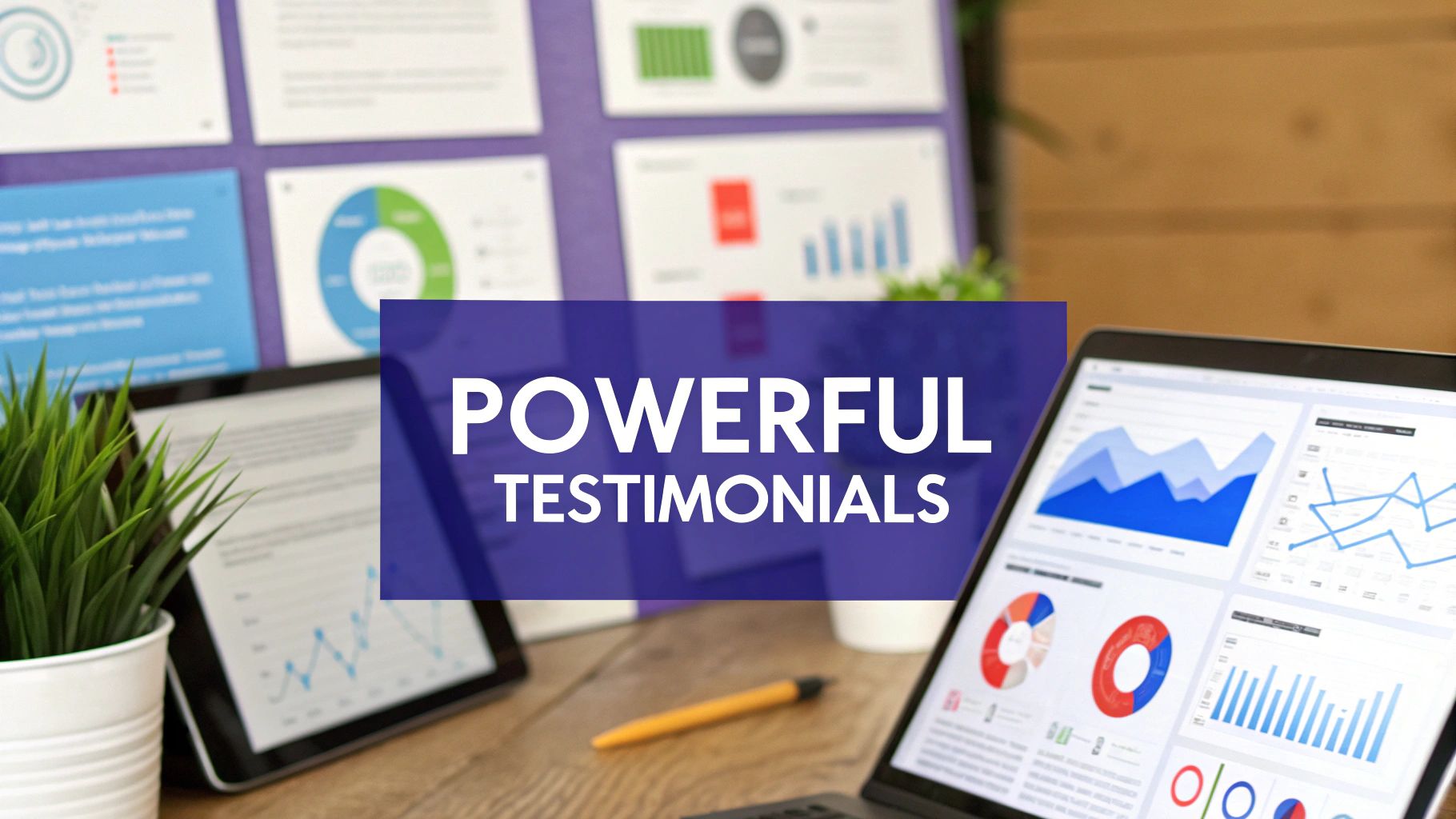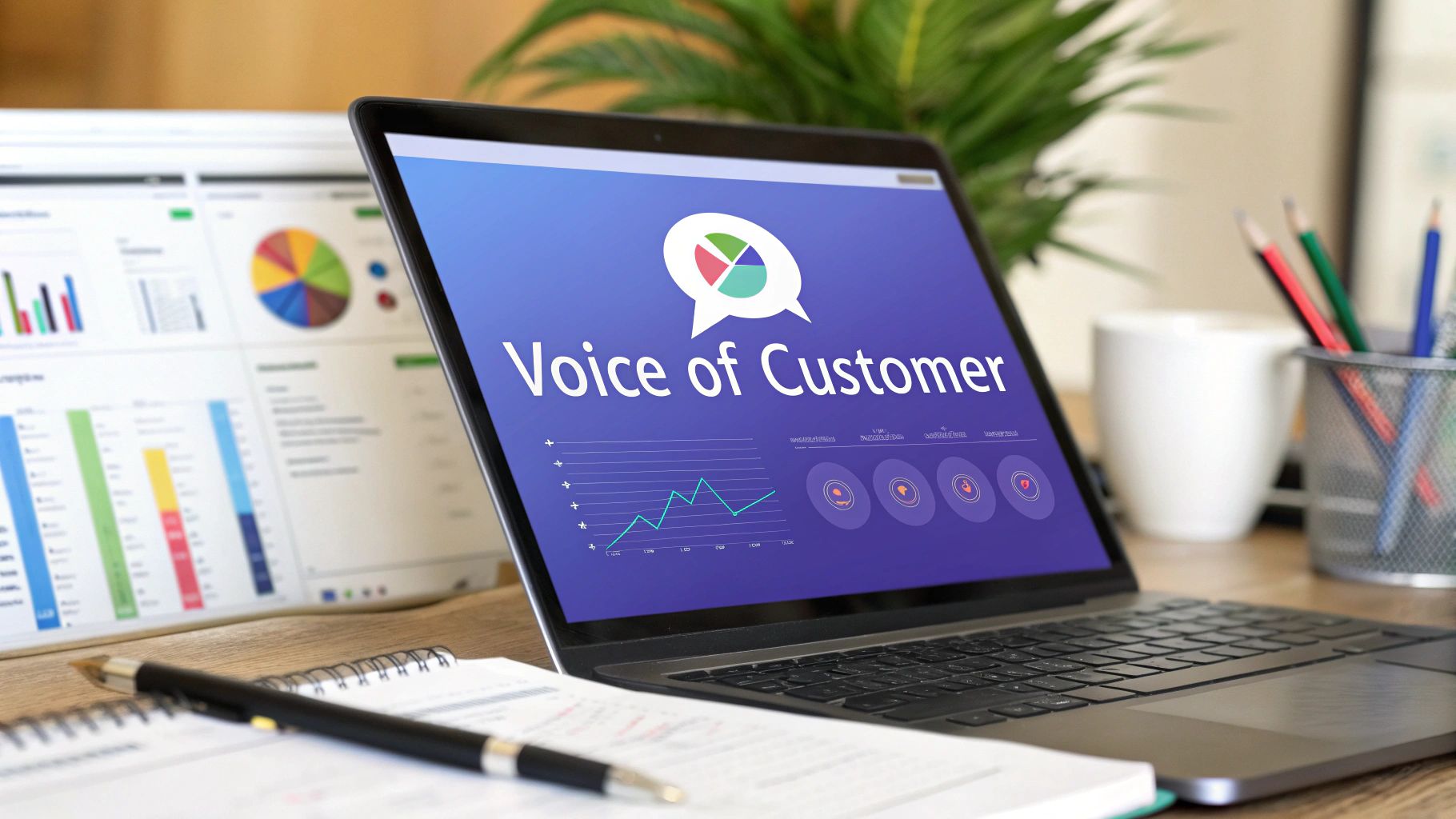7 Customer Onboarding Best Practices for SaaS in 2025
Discover the top 7 customer onboarding best practices for SaaS. Learn to reduce churn and boost retention with actionable strategies from industry leaders.
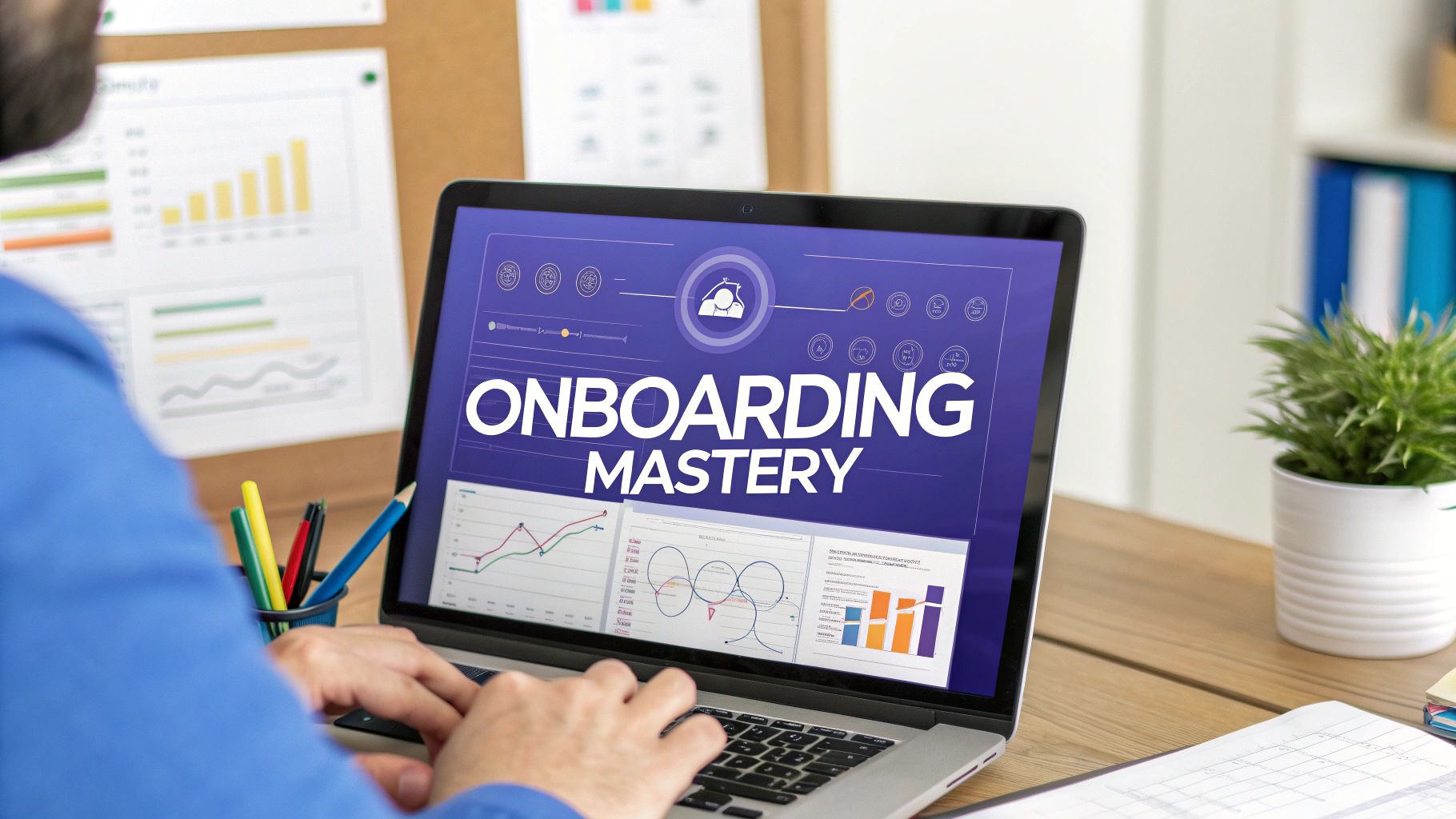
In the competitive SaaS landscape, a powerful first impression isn't just a nice-to-have; it's a critical driver of long-term success. The initial moments a user spends with your product, the onboarding process, determine their path to becoming either a loyal advocate or a churn statistic. Poor onboarding leads to confusion, low feature adoption, and ultimately, lost revenue. Conversely, exceptional onboarding sets the stage for high engagement, deep product understanding, and sustainable growth.
This guide moves beyond generic advice to provide a detailed roadmap of the top 7 customer onboarding best practices that leading SaaS companies are using to win. To truly ensure your first impression sets the stage for lasting customer relationships, explore developing a robust Customer Onboarding Process That Actually Keeps Customers as a foundational step.
We'll break down each strategy with actionable implementation steps, real-world examples, and key metrics to track. This will empower your team to create an experience that doesn't just welcome users, but guides them directly to value and turns them into lifelong customers. You will learn how to implement progressive onboarding, create personalized welcome experiences, and leverage interactive tours to showcase your product's power from day one.
1. Master Progressive Onboarding: Guide, Don't Overwhelm
The single biggest mistake in customer onboarding is trying to show new users everything at once. This "feature dumping" approach overwhelms people, creates cognitive friction, and often leads them to abandon your product before they experience its true value. Progressive onboarding is the antidote, a strategic method that introduces features and complexity gradually, aligning with the user's growing proficiency and needs.
Instead of a firehose of information, this best practice delivers a curated learning path. It guides users from an initial "aha!" moment to advanced usage by revealing functionality contextually. This could be based on time, specific actions taken, or milestones reached, ensuring the user always sees the right feature at the right time. The goal is to build confidence and momentum, making the journey from novice to power user feel natural and rewarding.
How Progressive Onboarding Works in Practice
Think of how successful apps guide you. Language-learning app Duolingo doesn't show you leaderboards and advanced grammar lessons on day one; it starts with basic vocabulary and unlocks new features as you gain experience. Similarly, Slack introduces core messaging first, then gradually unveils more complex tools like Huddles and Workflows as your team's communication patterns mature.
This method transforms a potentially intimidating first login into an achievable series of small wins. By mastering one concept before moving to the next, users build a solid foundation, which significantly increases long-term retention and product adoption.
The flow of a successful progressive onboarding strategy often follows a clear, repeatable pattern. The following infographic visualizes this core process, breaking it down into three key stages that guide users from initial interaction to celebrated achievement.
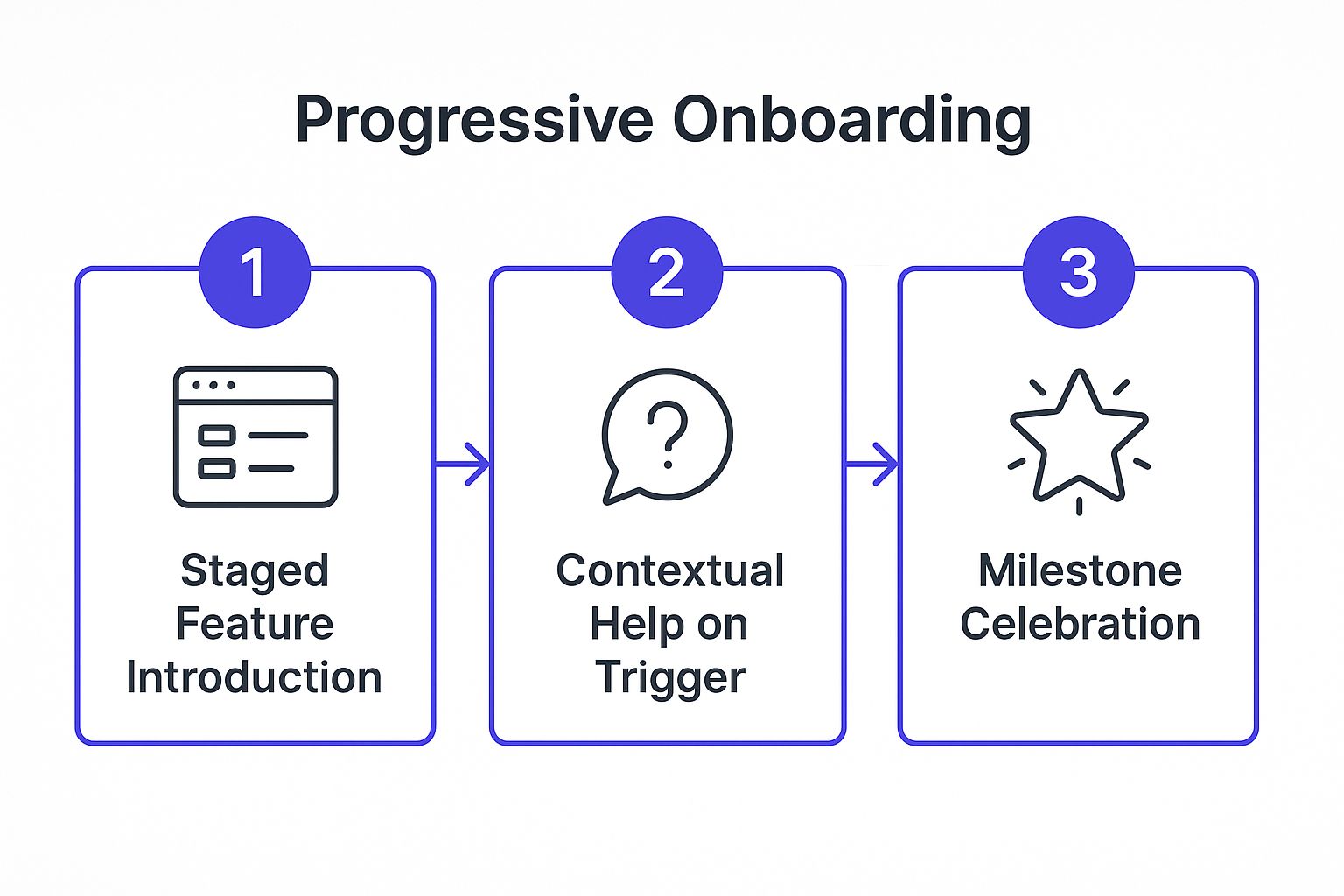
This sequence ensures that users are not just shown features but are actively supported and encouraged as they engage with them, reinforcing positive behavior.
Actionable Implementation Tips
To effectively implement this strategy, your team needs a deep understanding of the user journey.
- Map Features to User Stages: Identify the key stages of user engagement (e.g., Setup, First Value, Advanced Use). Assign your features to these stages, ensuring you only introduce what is necessary at each point.
- Use Behavioral Triggers: Leverage product analytics to trigger in-app guidance. For example, when a user creates their third project, you could introduce a tooltip highlighting a collaboration feature.
- Always Offer an Exit: Remember that not all users are beginners. Always provide a clear "skip tour" or "explore on my own" option for experienced individuals who don't need hand-holding.
By adopting this approach, you create a more tailored and effective user experience. To dive deeper into structuring these flows, explore these additional onboarding best practices from Surva.ai.
2. Create a Personalized Welcome Experience
A generic, one-size-fits-all onboarding flow treats every new user the same, ignoring their unique roles, goals, and needs. This missed opportunity can make your product feel irrelevant and generic, failing to connect with users on a personal level. Creating a personalized welcome experience is a powerful customer onboarding best practice that tailors the initial journey, making users feel understood and showing them the most relevant path to value from their very first interaction.
This strategy goes beyond simply using a [first_name] tag in a welcome email. It involves customizing the entire initial experience based on data collected during signup, such as role, industry, company size, or stated goals. By doing so, you demonstrate from the outset that your product is specifically designed to solve their problems. This relevance accelerates their "aha!" moment and builds immediate rapport, which is crucial for long-term loyalty and engagement.
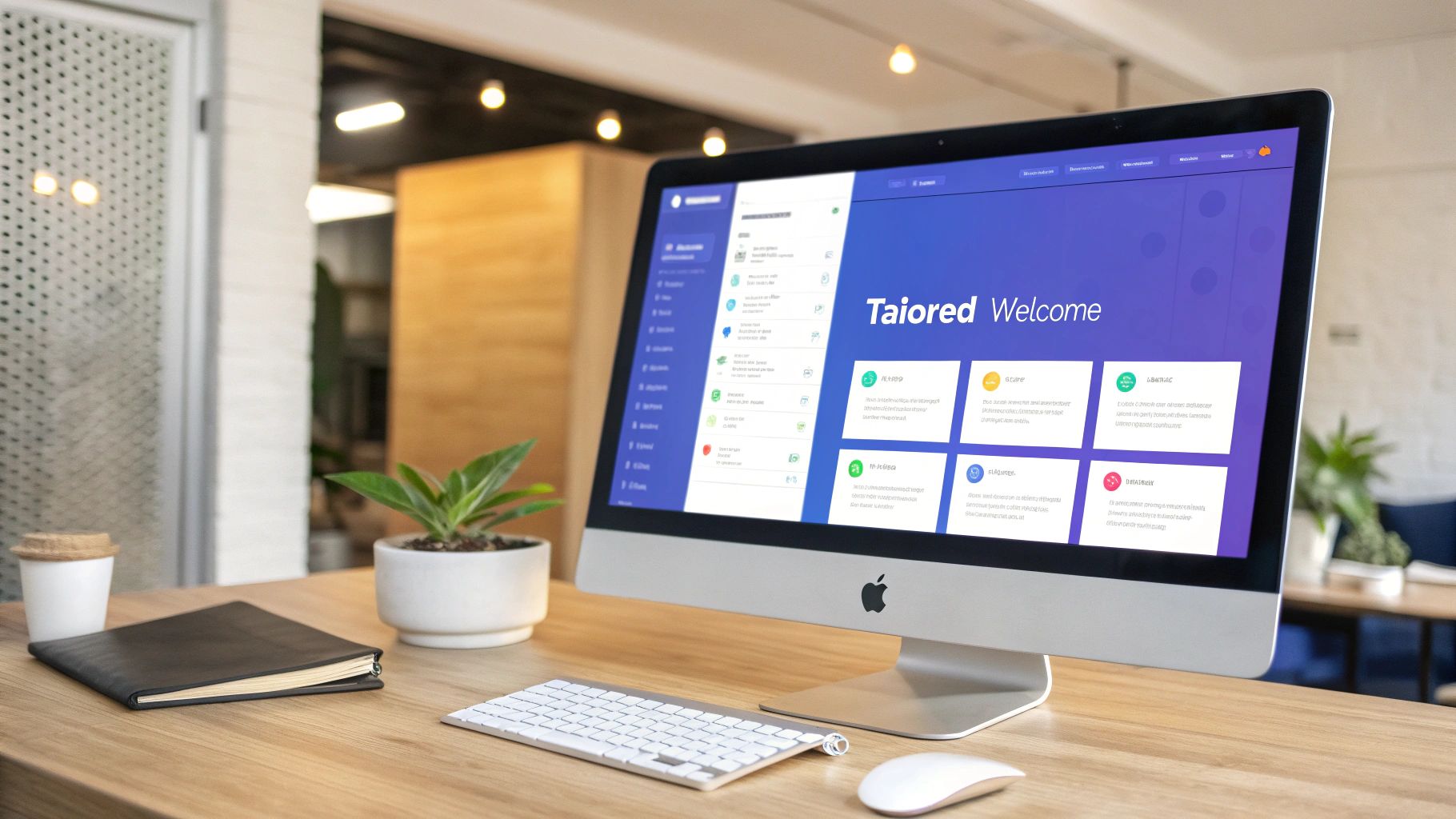
How Personalization Works in Practice
Leading SaaS companies masterfully use personalization to guide different user segments. HubSpot, for example, asks for your company size and industry during signup. This information then dictates the initial dashboard setup and the onboarding checklists you receive, ensuring a marketer at a large enterprise sees different guidance than a small business owner. Similarly, Salesforce provides role-specific layouts, so a sales manager’s initial view highlights team performance dashboards, while a sales rep sees their personal pipeline and activity feed first.
This tailored approach immediately frames the product within the user's specific context. Instead of forcing them to find value, you bring the most relevant value directly to them. This dramatically reduces friction and confusion, making users feel confident and capable right away. By showing them a clear path forward that acknowledges their identity, you transform a generic tool into a personal solution.
Actionable Implementation Tips
To deploy an effective personalized welcome, your team must be strategic about data collection and application.
- Collect Key Data During Signup: Add a few simple questions to your signup form to capture essential segmentation data. Ask for their role (e.g., "Marketer," "Sales Rep," "Developer") or primary goal ("I want to increase leads," "I want to manage projects").
- Create Persona-Based Templates: Develop distinct onboarding flows, checklists, and welcome screens for your most common user personas. Use this to highlight the features that are most critical for each segment's success.
- Leverage Progressive Profiling: Avoid overwhelming users with a long initial form. Collect the most crucial data upfront and then ask for more information contextually over time as they engage with the product. For example, prompt for more details when they first access a specific feature.
Implementing these personalization tactics is a core component of modern customer onboarding best practices. To learn more about how to structure these user journeys, consider this helpful guide on crafting onboarding flows from Userpilot.
3. Embrace Interactive Product Tours to Accelerate Learning
Static help articles and video libraries have their place, but nothing beats learning by doing. Interactive product tours guide new users through your platform's most critical features and workflows directly within the interface. By using a series of tooltips, modals, and guided steps, you provide a hands-on learning experience that is far more engaging and memorable than passive observation. This is a cornerstone of modern customer onboarding best practices because it bridges the gap between seeing and understanding.
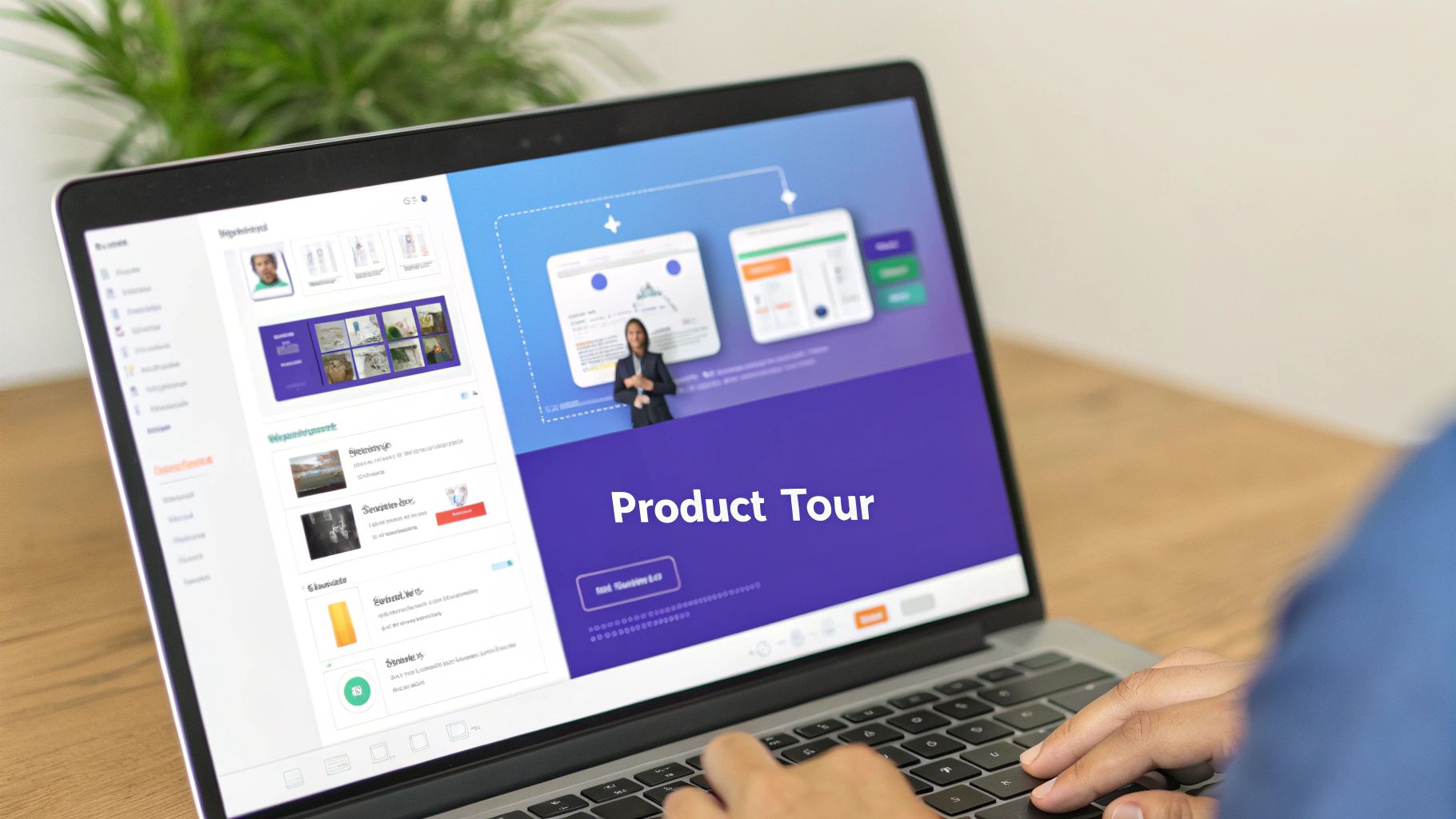
This method empowers users to complete their first meaningful actions quickly, building their confidence and demonstrating the product's value firsthand. Instead of just reading about how to create their first project, they are actively walked through the process, clicking the right buttons and filling in the right fields. This active participation significantly boosts comprehension and retention, turning a potentially confusing first session into a successful one.
How Interactive Product Tours Work in Practice
Leading SaaS companies excel at this. Notion doesn't just give you a blank page; it offers a guided workspace setup that walks you through creating your first database and page. Similarly, design tool Figma provides an interactive walkthrough to help new users understand its core vector editing and collaboration tools in a real project environment. Airtable also uses this approach effectively, guiding users through the creation of their first base.
These tours are effective because they are contextual and action-oriented. They focus on achieving a specific outcome, which is precisely what a new user wants to do. This video from UserGuiding demonstrates how these tours can be built and deployed to improve the user experience.
By making the initial learning curve feel like a guided game, you reduce friction and help users reach their "aha!" moment faster.
Actionable Implementation Tips
A successful interactive tour is more than just a sequence of tooltips; it's a carefully choreographed learning journey.
- Focus on Core Workflows: Don't try to show every single feature. Identify the one or two "must-do" actions that deliver initial value and build your tour around them.
- Make Tours Skippable and Replayable: Respect the user's autonomy. Always provide a clear "skip" or "exit" option for those who prefer to explore on their own, and make the tour accessible later from a help menu.
- Use Real or Realistic Data: Pre-populate templates with sample data that makes the experience feel authentic. This helps users visualize how the product will work for them.
- Keep It Short and Sweet: Aim for tours that take no more than 2-3 minutes to complete. Break down complex processes into multiple, shorter tours that can be triggered contextually.
4. Set Clear Success Metrics and Milestones
A successful onboarding journey isn't a vague tour; it's a purposeful path toward a defined goal. Without clear milestones, users can feel lost, unsure if they are making progress or even using the product correctly. Defining and communicating specific, measurable success metrics gives users a clear understanding of what "winning" with your product looks like, providing motivation and a sense of accomplishment.
This best practice transforms onboarding from a passive experience into an active, goal-oriented process. By establishing clear benchmarks, you not only guide the user but also create a framework for measuring the effectiveness of your own onboarding flow. When users know what to do next and why it matters, they are far more likely to invest the time needed to reach their first "aha!" moment and see tangible value.
How Success Metrics Work in Practice
Think about the motivating power of a progress bar. LinkedIn masterfully uses this by showing a "Profile Strength" meter, encouraging users to add skills, experience, and a photo to reach "All-Star" status. Similarly, Dropbox provides a setup checklist that rewards users with extra storage space for completing key actions like uploading a file and sharing a folder. These are not just tasks; they are celebrated milestones on the path to becoming an engaged user.
Each completed milestone acts as a small victory, releasing a bit of dopamine and building momentum. This gamified approach keeps users engaged and focused on the actions that are most likely to lead to long-term retention and success. It clearly communicates value by tying user actions directly to desired outcomes.
Actionable Implementation Tips
To effectively integrate this into your customer onboarding, you must align your metrics with genuine user value.
- Choose Metrics Tied to Retention: Analyze your most successful customers. What actions did they take within their first week? These actions, like creating a Trello board or inviting a teammate, should become your core onboarding milestones.
- Make Progress Visible and Rewarding: Use checklists, progress bars, or even celebratory modals to highlight when a user completes a key step. Visual feedback is crucial for reinforcing positive behavior and making progress feel tangible.
- Keep Goals Achievable but Meaningful: The first milestone should be a quick win that demonstrates immediate value. Subsequent goals can require more effort but should always align with the user's primary reason for signing up.
By setting these clear expectations, you create a powerful feedback loop for both the user and your team. To build a comprehensive framework around these goals, consider creating a dedicated plan using these insights on developing a customer success plan from Surva.ai.
5. Implement a Multi-Channel Communication Strategy
Relying on a single channel, like email, for onboarding is a risky bet. Users today interact with brands across numerous platforms, and their attention is fragmented. A multi-channel communication strategy meets users where they are, leveraging a mix of email, in-app messages, SMS, and even social media to deliver a cohesive and persistent onboarding experience. This approach ensures critical guidance isn't missed and caters to individual user preferences for receiving information.
This best practice is about creating a unified, redundant messaging system. An essential welcome email might be reinforced by a concise in-app notification upon first login, and a milestone achievement could be celebrated with both a congratulatory message and a follow-up email detailing next steps. The goal is to create a seamless narrative across platforms, making the onboarding journey feel supportive and ever-present without being intrusive.
How Multi-Channel Communication Works in Practice
Leading SaaS companies master this by coordinating their touchpoints. Shopify, for instance, guides new merchants through store setup using a powerful combination of platform checklists, educational emails, and community forum prompts. Similarly, Intercom is a prime example of a company that not only provides the tools for this but uses them effectively, combining its in-app messenger for contextual tips with email campaigns for feature announcements and re-engagement.
This strategy transforms onboarding from a monologue into a dynamic conversation. By giving users control over their communication preferences and using analytics to determine which channels are most effective for specific messages, you increase engagement and reduce the friction caused by missed or ignored communications.
Actionable Implementation Tips
To execute a multi-channel strategy, your team must orchestrate communication, not just send messages.
- Maintain Brand and Message Consistency: Your tone, language, and core message must be consistent across all channels to avoid confusing the user. The goal is one unified experience, not several disjointed ones.
- Empower Users with Preferences: Always provide an easy-to-find communication settings page where users can opt in or out of different channels (e.g., "Email me for product updates, but send SMS for security alerts").
- Analyze Channel Performance: Use analytics to track which channels drive the most engagement for specific types of messages. An email might work best for a weekly digest, while an in-app prompt is better for a time-sensitive feature tutorial.
- Avoid Message Overload: Map out your communication flow to ensure you aren't bombarding users. If a user completes an action from an in-app prompt, suppress the follow-up email that asks them to do the same thing.
By adopting this approach, you create a more robust and user-centric onboarding system. To truly master seamless communication and deliver a cohesive user experience, extend your approach to encompass proven omnichannel customer service strategies. To learn more about applying this concept to user feedback, explore these multi-channel survey strategies from Surva.ai.
6. Weave in Human Touch and Support Integration
While automation is a cornerstone of scalable onboarding, removing human interaction entirely can leave customers feeling isolated and unsupported. The most effective strategies blend digital efficiency with a personalized, human touch. This best practice involves integrating real people, such as onboarding specialists or support agents, at critical junctures to build trust, address complex issues, and forge a stronger customer relationship from day one.
This high-touch approach doesn't mean manually guiding every user. Instead, it’s about strategically deploying human support where it delivers the most value. This could be a scheduled welcome call, proactive live chat assistance, or access to a dedicated customer success manager. The goal is to show users that behind the polished interface, there's a team invested in their success, ready to help them overcome hurdles and achieve their goals.
How Human Touch Works in Practice
High-touch support is particularly crucial for complex B2B SaaS products or high-value enterprise accounts. For instance, scheduling platform Calendly offers dedicated onboarding calls for its enterprise customers, ensuring large teams are set up for success. Similarly, customer service software provider Zendesk assigns customer success managers to key accounts to provide personalized guidance and strategic advice throughout their journey.
Even for more self-serve products, human touch can be a powerful differentiator. Atlassian cultivates a vibrant user community where customers can get peer-to-peer help, supplementing its formal support channels. This not only solves problems but also builds a network of brand advocates. This balanced approach ensures that even as you scale, you don't lose the personal connection that drives long-term loyalty and satisfaction.
Actionable Implementation Tips
To effectively integrate human touch into your customer onboarding best practices, you need to be strategic and proactive.
- Segment for High-Touch Support: Identify user segments that would benefit most from human interaction, such as enterprise clients or users struggling with key activation steps. Use product analytics to flag these users for proactive outreach.
- Train Your Onboarding Team: Your customer-facing teams are an extension of your product. Train them not just on features, but on the principles of effective onboarding, empathy, and problem-solving to ensure a consistent, high-quality experience.
- Balance Automation and Personalization: Use automation to handle routine tasks and trigger alerts for human intervention. For example, an automated email can offer to schedule a call with a specialist if a user hasn't completed a critical setup task within 48 hours.
7. Quick Wins and Early Value Demonstration
One of the most effective customer onboarding best practices is to focus on delivering a "quick win" for the user immediately. This strategy is centered on guiding new customers to their first moment of success as swiftly as possible, ideally within their very first session. By prioritizing features that showcase your product's core value proposition right away, you prove its worth and create an essential "aha!" moment that builds user motivation.
This approach directly combats early-stage churn, which often occurs when users feel lost or don't see an immediate return on their time investment. A quick win confirms their decision to sign up was the right one, transforming initial curiosity into genuine engagement. It’s the difference between a user thinking, "This seems complicated," and "Wow, I already accomplished something valuable."

How Quick Wins Work in Practice
Think about the first time you used Canva. You weren't forced to learn every design tool; instead, you were guided toward pre-made templates, allowing you to create a professional-looking graphic in minutes. This is a classic quick win. Similarly, Grammarly provides immediate value by highlighting errors and offering suggestions as you type, demonstrating its benefit without any complex setup.
These experiences are powerful because they require minimal effort from the user to achieve a meaningful outcome. The goal is to shrink the "Time to First Value" (TTFV), a critical metric that measures how long it takes a new user to realize the benefit they signed up for. A shorter TTFV correlates strongly with higher activation rates and long-term retention.
Actionable Implementation Tips
To engineer quick wins into your onboarding, you need to identify and streamline the shortest path to value.
- Identify the Core "Aha!" Moment: What is the one key action or outcome that makes users understand your product's value? Build your initial onboarding flow around getting them to that point as fast as possible.
- Use Templates and Pre-populated Data: Remove the "blank slate" problem. Offer templates, sample projects, or pre-filled data to help users visualize the end result and get started instantly.
- Remove Friction from Initial Workflows: Scrutinize your signup and setup process. Eliminate every non-essential field, step, or decision that stands between the user and their first quick win.
- Measure Time to First Value (TTFV): Use product analytics to track how long it takes users to complete that key value-driving action. Continuously experiment to reduce this time.
By focusing on a quick win, you're not just onboarding a user; you're building their confidence and giving them a compelling reason to stick around. To learn more about designing these impactful initial experiences, consider these SaaS onboarding examples from Userpilot.
Best Practices Comparison for Customer Onboarding
From Onboarding to Advocacy: Your Next Steps
We've explored a powerful set of customer onboarding best practices, moving far beyond a simple "welcome" email. From the precision of progressive onboarding and personalized welcomes to the engagement of interactive product tours, the goal is clear: guide new users to their "Aha!" moment as efficiently as possible. This initial experience sets the entire tone for the customer relationship.
By focusing on clear success milestones, implementing a multi-channel communication strategy, and strategically integrating the human touch, you transform onboarding from a mere checklist into a dynamic, supportive journey. Remember, the true measure of success isn't just user activation; it's laying the groundwork for long-term retention and turning satisfied customers into vocal brand advocates.
Turning Theory into Action
The key takeaway is that effective onboarding is not a one-size-fits-all solution. It's an iterative process built on understanding your specific users and the unique value your product delivers. Don't feel overwhelmed by the need to implement all seven strategies at once. Instead, adopt a focused, incremental approach.
Here are your actionable next steps:
- Audit Your Current Flow: Start by mapping out your existing onboarding process. Where are users dropping off? What questions are they asking support most frequently? Identify the one or two biggest friction points.
- Select a Starting Point: Choose a single best practice from this list that directly addresses your biggest challenge. Is your product complex? Start with progressive onboarding. Are users struggling to see value? Focus on demonstrating quick wins.
- Implement and Measure: Define what success looks like for your chosen strategy. This could be an increase in a key activation metric, a reduction in support tickets, or a higher completion rate for your product tour. Track these metrics diligently.
- Gather Direct Feedback: Quantitative data tells you what is happening, but qualitative feedback tells you why. Ask your users about their experience directly. What was confusing? What was most helpful? This insight is invaluable for refinement. For an even broader perspective and more in-depth approaches, explore a range of comprehensive customer onboarding strategies to complement these practices.
The Foundation of Sustainable Growth
Mastering these customer onboarding best practices is more than just an optimization task; it's a fundamental pillar of sustainable SaaS growth. A superior onboarding experience directly impacts every crucial metric you care about: it boosts activation rates, increases feature adoption, reduces early-stage churn, and improves long-term customer lifetime value.
By investing in a thoughtful, user-centric onboarding process, you are building a powerful competitive advantage. You're not just selling software; you're building relationships and ensuring your customers have the tools and knowledge to succeed from their very first interaction. This commitment is what separates fast-growing companies from the rest.
Ready to understand exactly where users get stuck in your onboarding flow? Surva.ai helps you collect real-time feedback by embedding beautiful, non-intrusive surveys directly into your product. Find your "why" and start building a better onboarding experience today at Surva.ai.
